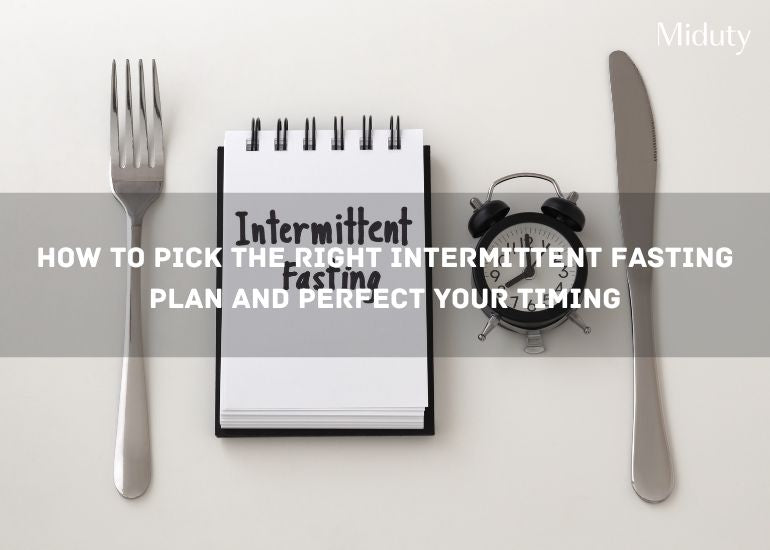
How to Pick the Right Intermittent Fasting Plan and Perfect Your Timing
Introduction | Popular Intermittent Fasting Plans | Fasting Timings | Common Mistakes with Timings | Key Rules to Follow | Customised Fasting Plans| Conclusion | FAQs | References
Key Takeaways
- Choosing the Right Fasting Plan: Tailor your intermittent fasting schedule to suit your lifestyle and goals, whether it’s weight loss, mental clarity, or muscle gain. Popular plans include the 16/8 method, 5:2 diet, and alternate-day fasting.
- Timing Matters for Optimal Results: Fasting during specific times can boost results. For example, morning fasts with early evening meals support weight loss by leveraging higher insulin sensitivity earlier in the day.
- Maximizing Nutrition: During the eating window, focus on nutrient-dense foods—lean proteins, healthy fats, and fiber-rich veggies—to maintain energy and balance blood sugar levels.
- Hydration and Electrolytes: Stay hydrated with water, tea, or black coffee during fasting, and replenish electrolytes, especially during longer fasts, to prevent dehydration and fatigue.
- Lifestyle Fit: Intermittent fasting is highly customizable. Select a plan that complements your routine, whether you need flexibility like the 5:2 diet or a structured plan like the 16/8 method.

Introduction
Intermittent fasting has become a go-to method for people seeking weight loss, mental clarity, and longevity. But for those who practice it, it's not just about skipping meals—it’s about timing. Knowing when to fast is just as crucial as what you eat when you break your fast. Whether you're doing the 16/8 method, alternate-day fasting, or experimenting with a 24-hour fast, finding the right schedule can make or break your progress.
For many of us, fasting during the evening and overnight feels natural, while others prefer morning fasts to kickstart their day with mental clarity. And let’s not forget, life gets in the way. You have work, family, and fitness goals, so finding a fasting plan that fits your lifestyle is key to making it sustainable.
What works for one person might not work for another. Some people thrive on a strict schedule, while others need more flexibility. The right timing helps you manage hunger and maximizes fat-burning and energy levels throughout the day.
So, if you’ve been fasting for a while but feel stuck, it might be time to revisit when you’re fasting, not just how.
Read more: Intermittent Fasting 101
Popular Intermittent Fasting Plans: Breaking Down the Structures

There isn't a one-size-fits-all approach to intermittent fasting, and that's the beauty of it. Different plans cater to different needs. Here's a look at the most popular methods and what makes them unique:
|
IF Method |
Description |
Pattern |
Who is it for? |
|
16/8 Method |
Fast for 16 hours and eat during an 8-hour window. Popular for its simplicity and sustainability. |
16-hour fast, 8-hour eating window |
Beginners seeking an easy-to-follow plan, fat loss, and better energy regulation. [1] |
|
5:2 Diet |
Eat normally for five days; restrict to 500-600 calories for two non-consecutive days. |
5 regular days, 2 low-calorie days |
Those who want fasting benefits with minimal restrictions. Suitable for people who can handle short-term calorie deprivation. [2] |
|
Alternate Day Fasting |
Fast every other day with up to 500 calories on fasting days; eat normally on non-fasting days. |
Alternate fasting and eating days |
Suitable for individuals seeking rapid weight loss or metabolic improvements who can manage extended hunger; not ideal for beginners or those sensitive to hunger. [3] |
|
24 Hour Fast (Eat-Stop-Eat) |
Fast for 24 hours once or twice a week, typically from dinner to dinner |
A 24-hour fast once or twice weekly |
People comfortable with longer fasting periods who don’t wish to fast daily but want noticeable results. [4] |
|
The Warrior Diet |
Small amounts of raw fruits/vegetables during the day and one large meal at night simulate ancient warrior eating patterns. |
Small daytime snacks, large evening meal |
Active individuals who prefer grazing during the day and enjoy a large dinner, with flexibility and a dislike for frequent, small meals. [5] |
Fasting Times: Maximizing Results with Proper Timing

One of the biggest misconceptions about intermittent fasting is that you can fast at any time of the day and get the same results. The truth is, timing matters, and the right schedule can accelerate your progress.
Optimal Fasting Windows
Fasting windows can be customized based on your daily routine, but the time of day you fast can significantly affect your results. Most people find that fasting during the evening and through the night works best because it aligns with the body’s natural circadian rhythm.
For instance, the 16/8 method can be optimized by eating between 12 p.m. and 8 p.m. This allows for a fasted state while you sleep and breaks the fast at a convenient time during the day.
You can watch this detailed video on Intermittent Fasting to get more detailed information
Fasting for Specific Goals
- Weight loss: Morning fasts combined with early evening meals are ideal, as insulin sensitivity is higher earlier in the day. This optimizes fat burning.
- Mental clarity: Fasting until the late morning or afternoon can lead to better mental focus, as the absence of food can improve cognitive function.
- Muscle gain: A shorter fasting window (like 14/10) may work better for muscle gain, ensuring more frequent feeding to support muscle protein synthesis.
- Detoxification: During intermittent fasting, the body undergoes a natural detoxification process, where it clears out toxins and damaged cells, promoting cellular repair and improved overall health.
- Satiety: Intermittent fasting enhances satiety by encouraging more balanced meals during eating windows, reducing frequent hunger pangs and the urge to overeat, which supports weight management.
- Sugar Control: Intermittent fasting helps regulate blood sugar levels by improving insulin sensitivity, leading to fewer blood sugar spikes and crashes, which supports stable energy and reduces the risk of metabolic disorders.
- Heart Health: Intermittent fasting can lower blood pressure, LDL cholesterol, and inflammation levels, which collectively improve cardiovascular health and reduce the risk of heart disease.
- Endurance and Stamina: Fasting encourages the body to use fat as a fuel source, which can improve endurance for athletes by training the body to access energy from stored fat, thus enhancing stamina.
- Hormone Balance: Fasting influences hormone levels by increasing human growth hormone (HGH) and improving insulin sensitivity, both of which support metabolism, muscle growth, and fat loss.
- Cellular Longevity: Fasting triggers autophagy, a cellular "recycling" process that removes damaged cells and proteins, which is linked to anti-aging benefits and may reduce the risk of age-related diseases.
- Digestive Health: Fasting gives the digestive system a break, allowing for improved gut health and reduced inflammation. This can lead to better nutrient absorption and digestion over time.
Common Mistakes with Fasting Timing
Intermittent fasting offers health benefits, but timing is key to success. Overfasting—extending fasting hours without adequate nutrition—can lead to fatigue and nutrient deficiencies. Start with a manageable fasting window and listen to your body’s signals to avoid burnout and maximize energy.
Undereating during the eating window is another common mistake, which can slow metabolism and hinder weight loss. Aim to eat nutrient-dense foods with proteins, healthy fats, and complex carbs to stay energized.
You can download the free Miduty Intermittent Fasting Diet Plan to learn exactly what to eat and when to eat during your fasting and eating windows. This guide provides a balanced meal schedule to support your energy and nutrition goals with intermittent fasting.
Finishing your last meal earlier in the evening promotes better sleep and metabolic balance. To support nutrition, consider a multivitamin with high-quality protein to fill gaps, especially on restricted eating plans.
Key Rules to Follow During Intermittent Fasting
While fasting seems straightforward, there are essential rules to follow to maximize benefits:
1. Hydration and Electrolytes
Staying hydrated is crucial during fasting periods. Water, black coffee, and unsweetened teas are all allowed but don’t forget to replenish electrolytes, especially if fasting for extended periods. Without proper electrolyte balance, you risk dehydration and fatigue.
2. Nutrient Timing
When it’s time to break your fast, focus on nutrient-dense meals. The goal is to fill your eating window with whole foods—proteins, healthy fats, and fiber-rich vegetables. Avoid breaking your fast with sugar-heavy or ultra-processed foods, as this can spike blood sugar levels and undo the benefits of fasting.
3. Exercise and Fasting
Exercising during intermittent fasting can be highly effective, especially for fat loss. However, timing matters. Fasted cardio is great for fat burning, while strength training is often better done toward the end of your fasting window when you’re about to break your fast. This way, your body has access to nutrients for recovery.
4. Breaking the Fast
Breaking your fast correctly is critical. Avoid going straight for heavy meals or junk food, which can overwhelm your digestive system. Instead, start with something light and nutrient-dense, like a smoothie, and give your body time to adjust before having a more substantial meal.
Customizing Your Fasting Plan: What Works for Your Lifestyle?
One of the most important aspects of intermittent fasting is making sure it fits into your lifestyle. While some people thrive on the 16/8 plan, others may find the 5:2 or 24-hour fast more manageable. The key is finding what works for your daily routine, fitness goals, and personal preferences.
If you have a demanding job or family life, a flexible plan like the 5:2 diet or the Warrior Diet might be a better fit. Those with more predictable schedules may benefit from stricter plans like the 16/8 or alternate-day fasting. The ultimate goal is to make fasting sustainable.
Conclusion
Intermittent fasting, when done correctly, can be a powerful tool for achieving your health and fitness goals. By choosing the right fasting plan, paying attention to timing, and following key rules, you can harness the full benefits of this ancient practice. Whether you're fasting for weight loss, muscle gain, or longevity, the key is to tailor your fasting schedule to your unique lifestyle and goals.

Frequently Asked Questions (FAQs)
Q1 - Will I lose muscle while fasting?
No, as long as you’re consuming enough protein during your eating window and engaging in strength training, your muscle mass will be preserved.
Q2 - Does fasting slow down metabolism?
Short-term fasting boosts metabolism, but prolonged, unstructured fasting can have the opposite effect if done incorrectly.
Q3 - What foods do you eat on intermittent fasting?
During intermittent fasting, focus on eating nutrient-dense foods like lean proteins, healthy fats, complex carbs, and plenty of vegetables during your eating window to stay energized and nourished.
Q4 - Which meal is best to skip for intermittent fasting?
The best meal to skip during intermittent fasting depends on your preference, but many find it easier to skip breakfast and start eating later in the day.

References








